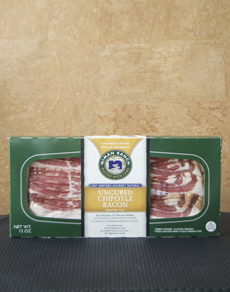TIP OF THE DAY: Bacon Makes It Better
|
|
If you’re looking for a way to change up your summer cole slaw and potato salad, we recommend bacon (or vegetarian bacon). Or, you can substitute the vegetarian, kosher Baconnaise, a bacon-flavored mayonnaise we love. Real bacon or faux flavor, the smokiness adds a level of deliciousness.
We presented a variation of this “red, white and blue” cole slaw recipe for Independence Day, but we didn’t add the bacon. Yesterday we found ourselves with a package of Niman Ranch bacon and this recipe from EatWisconsinCheese.com. We made it and declared it a hit. BACON COLE SLAW Ingredients cups) |
|
|
For Slaw Dressing
1. DRESSING. Combine all ingredients in a jar; cap and shake well. Refrigerate for an hour or longer to let the flavors blend. 2. COMBINE. Combine all ingredients in a large bowl; mix well. 3. CHILL. Refrigerate for at least an hour to let the flavors blend. Variations Cha Cha Chipotle Lemonaise Fire & Spice Lemonaise (tomato, cayenne and cumin) Garlic Herb Lemonaise Green Dragon Lemonaise (wasabi) Latin Lemonaise With Chiles, Lime & Cumin Lemonaise Lemonaise Light |
||
|
NIMAN RANCH BACON, NITRITES & OTHER THINGS YOU SHOULD KNOW
Niman Ranch bacon costs more, but its money well spent. All Niman Ranch meats support small, family-run, sustainably-managed American farms. The meats have much better flavor and texture than factory-farmed meat. (If you haven’t seen The Meatrix, it will open your eyes). The other difference is the cure—a topic filled with misinformation and controversy about nitrates and nitrites. The issues are presented below. Niman Ranch bacon has a noticeably lower moisture content than supermarket brands, and thus shrinks a bit less, with less curling, as it cooks. Another observation: The bacon is thicker and browns more slowly, so you can make it well done without over-crisping. |
 Niman Ranch Bacon. Photo by Evan Dempsey | THE NIBBLE. |
|
|
What Is Uncured Bacon? Conventional bacon gets a “quick cure”: The pork belly is injected with brine plus the chemical form of sodium nitrate (which converts to sodium nitrite in the processing). Sodium nitrite extends the shelf life of the meat, prevents bacterial growth and provides the familiar pink or red color. Uncured bacon typically uses a nitrate/nitrite-free cure with celery juice, salt and a lactic acid starter culture. Then why is it called “uncured?” Under federal labeling laws, if a meat product is not cured using the chemical form of sodium nitrate, it must be labeled uncured, whether or not it is preserved by another preservation technique. Add this to the mountains of confusing government legislation. It’s easy for most consumers to think that uncured meat is less preserved, and thus more dangerous (the danger is the potential growth of the bacterium Clostridium botulinum, which can cause botulism). But there’s more: Celery is a natural source of sodium nitrate, so nitrites go into the meat anyway. But by adding nitrite-rich celery juice to the meat instead of actual chemicals, manufacturers legally to claim “no added nitrates.” SODIUM NITRITE DOESN’T CAUSE CANCER Here’s the lowdown on this issue: Several decades ago, an animal study that got significant media attention concluded that sodium nitrite was a carcinogen. Large amounts of the chemical were fed to the animals. But follow-up studies—which did not get hyped by the media—did not show the correlation. According to MeatSafety.org: Numerous scientific panels have evaluated sodium nitrite safety and the conclusions have essentially been the same: sodium nitrite is not only safe, it’s an essential public health tool because it has a proven track record of preventing botulism. The National Toxicology Program, an agency within the U.S. Department of Health & Human Services, conducted a multi-year study to evaluate sodium nitrite’s safety. The study found that sodium nitrite was safe at the levels used. According to the FDA, sodium nitrite does not become toxic or increase risk of cancer in doses up to 10 mg of sodium nitrite per pound of body weight. This translates to an intake of 19 pounds of cured meat for a 150-pound individual. So: Buy Niman Ranch bacon because it’s sustainable and tastes better—not because of “no added nitrates or nitrites.”
|
||



